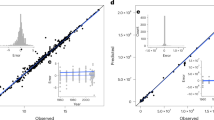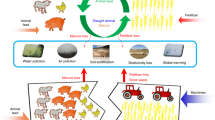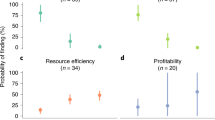Abstract
Rapid demographic ageing substantially affects socioeconomic development1,2,3,4 and presents considerable challenges for food security and agricultural sustainability5,6,7,8, which have so far not been well understood. Here, by using data from more than 15,000 rural households with crops but no livestock across China, we show that rural population ageing reduced farm size by 4% through transferring cropland ownership and land abandonment (approximately 4 million hectares) in 2019, taking the population age structure in 1990 as a benchmark. These changes led to a reduction of agricultural inputs, including chemical fertilizers, manure and machinery, which decreased agricultural output and labour productivity by 5% and 4%, respectively, further lowering farmers’ income by 15%. Meanwhile, fertilizer loss increased by 3%, resulting in higher pollutant emissions to the environment. In new farming models, such as cooperative farming, farms tend to be larger and operated by younger farmers, who have a higher average education level, hence improving agricultural management. By encouraging the transition to new farming models, the negative consequences of ageing can be reversed. Agricultural input, farm size and farmer’s income would grow by approximately 14%, 20% and 26%, respectively, and fertilizer loss would reduce by 4% in 2100 compared with that in 2020. This suggests that management of rural ageing will contribute to a comprehensive transformation of smallholder farming to sustainable agriculture in China.
This is a preview of subscription content, access via your institution
Access options
Access Nature and 54 other Nature Portfolio journals
Get Nature+, our best-value online-access subscription
$29.99 / 30 days
cancel any time
Subscribe to this journal
Receive 51 print issues and online access
$199.00 per year
only $3.90 per issue
Buy this article
- Purchase on Springer Link
- Instant access to full article PDF
Prices may be subject to local taxes which are calculated during checkout





Similar content being viewed by others
Data availability
Rural household survey data supporting this study are openly available at http://ssec.zju.edu.cn/dataset/CRHPS/. Source data are provided with this paper.
Code availability
All analyses were performed using Stata version 12.0. The codes are available in Supplementary Information, which allows the estimates to be reproduced.
References
Harper, S. Economic and social implications of aging societies. Science 346, 587–595 (2014).
Chen, C., Goldman, D. P., Zissimopoulos, J. & Rowe, J. W. Multidimensional comparison of countries’ adaptation to societal aging. Proc. Natl Acad. Sci. USA 115, 9169–9174 (2018).
Bloom, D. E. et al. Macroeconomic implications of population ageing and selected policy responses. Lancet 385, 649–657 (2015).
Yu, B., Wei, Y., Kei, G. & Matsuoka, Y. Future scenarios for energy consumption and carbon emissions due to demographic transitions in Chinese households. Nat. Energy 3, 109–118 (2018).
Li, M. & Sicular, T. Aging of the labor force and technical efficiency in crop production: evidence from Liaoning province, China. China Agric. Econ. Rev. 5, 342–359 (2013).
Ji, Y., Hu, X., Zhu, J. & Zhong, F. Demographic change and its impact on farmers’ field production decisions. China Econ. Rev. 43, 64–71 (2017).
Apipoonyanon, C. et al. Socio-economic and environmental barriers to increased agricultural production: new evidence from central Thailand. Outlook Agric. 50, 178–187 (2021).
Rigg, J., Phongsiri, M., Promphakping, B., Salamanca, A. & Sripun, M. Who will tend the farm? Interrogating the ageing Asian farmer. J. Peasant Stud. 47, 306–325 (2020).
Lutz, W., Sanderson, W. & Scherbov, S. The coming acceleration of global population ageing. Nature 451, 716–719 (2008).
Yang, J. et al. Projecting heat-related excess mortality under climate change scenarios in China. Nat. Commun. 12, 1039 (2021).
Chen, X., Huang, B. & Li, S. Population ageing and inequality: evidence from China. World Econ. 41, 1976–2000 (2018).
Zhang, X., Guo, F. & Zhai, Z. China’s demographic future under the new two-child policy. Popul. Res. Policy Rev. 38, 537–563 (2019).
Zeng, Y. & Hesketh, T. The effects of China’s universal two-child policy. Lancet 388, 1930–1938 (2016).
Satola, L. Problems of the aging of the farmers’ population in small farms in Poland. Sci. Pap. Ser. Manage. Econ. Eng. Agric. Rural Dev. 19, 305–310 (2019).
Cutler, J. et al. Ageing is associated with disrupted reinforcement learning whilst learning to help others is preserved. Nat. Commun. 12, 4440 (2021).
Huang, X., Lu, Q., Wang, L., Cui, M. & Yang, F. Does aging and off-farm employment hinder farmers’ adoption behavior of soil and water conservation technology in the Loess Plateau? Int. J. Clim. Change Strateg. Manage. 12, 92–107 (2020).
Min, S., Waibel, H. & Huang, J. Smallholder participation in the land rental market in a mountainous region of Southern China: impact of population aging, land tenure security and ethnicity. Land Use Policy 68, 625–637 (2017).
Li, S. et al. An estimation of the extent of cropland abandonment in mountainous regions of China. Land Degrad. Dev. 29, 1327–1342 (2018).
Jansuwan, P. & Zander, K. K. What to do with the farmland? Coping with ageing in rural Thailand. J Rural Stud. 81, 37–46 (2021).
Chen, R., Xu, P., Song, P., Wang, M. & He, J. China has faster pace than Japan in population aging in next 25 years. Biosci. Trends 13, 287–291 (2019).
Peng, X. China’s demographic history and future challenges. Science 333, 581–587 (2011).
Usman, M., Sawaya, A., Igarashi, M., Gayman, J. J. & Dixit, R. Strained agricultural farming under the stress of youths’ career selection tendencies: a case study from Hokkaido (Japan). Hum. Soc. Sci. Commun. 8, 19 (2021).
Ren, C. et al. The impact of farm size on agricultural sustainability. J. Clean. Prod. 220, 357–367 (2019).
Zhang, X. et al. Quantitative assessment of agricultural sustainability reveals divergent priorities among nations. One Earth 4, 1262–1277 (2021).
Ren, C. et al. Fertilizer overuse in Chinese smallholders due to lack of fixed inputs. J. Environ. Manage. 293, 112913 (2021).
Wu, Y. et al. Policy distortions, farm size, and the overuse of agricultural chemicals in China. Proc. Natl Acad. Sci. USA 115, 7010–7015 (2018).
Yu, Y., Hu, Y., Gu, B., Reis, S. & Yang, L. Reforming smallholder farms to mitigate agricultural pollution. Environ. Sci. Pollut. Res. 29, 13869–13880 (2022).
Fang, D. & Guo, Y. Induced agricultural production organizations under the transition of rural land market: evidence from China. Agriculture 11, 881 (2021).
China Statistics Press. China Statistical Yearbook (China Statistical Publishing House, 2020).
Guo, A., Ding, X., Zhong, F., Cheng, Q. & Huang, C. Predicting the future Chinese population using Shared Socioeconomic Pathways, the Sixth National Population Census, and a PDE model. Sustainability 11, 3686 (2019).
O Neill, B. C. et al. The roads ahead: narratives for shared socioeconomic pathways describing world futures in the 21st century. Glob. Environ. Change 42, 169–180 (2017).
Chen, X. Vigorously cultivating new agricultural business subjects—a message at the Annual Meeting of the China Agricultural Economics Association (in Chinese). Issues Agric. Econ. 35, 4–7 (2014).
Zhu, Z. et al. Integrated livestock sector nitrogen pollution abatement measures could generate net benefits for human and ecosystem health in China. Nat. Food 3, 161–168 (2022).
Bai, Z. et al. China’s livestock transition: driving forces, impacts, and consequences. Sci. Adv. 4, r8534 (2018).
Zhang, C. et al. Rebuilding the linkage between livestock and cropland to mitigate agricultural pollution in China. Resour. Conserv. Recycl. 144, 65–73 (2019).
Jin, S. et al. Decoupling livestock and crop production at the household level in China. Nat. Sustain. 4, 48–55 (2021).
Xia, L., Lam, S. K., Yan, X. & Chen, D. How does recycling of livestock manure in agroecosystems affect crop productivity, reactive nitrogen losses, and soil carbon balance? Environ. Sci. Technol. 51, 7450–7457 (2017).
Borychowski, M., Sapa, A., Czyżewski, B., Stępień, S. & Poczta-Wajda, A. Interactions between food and nutrition security and the socio-economic and environmental dimensions of sustainability in small-scale farms: evidence from a simultaneous confirmatory factor analysis in Poland. Int. J. Agric. Sustain. 20, 998–1014 (2022).
Gu, B., Zhang, X., Bai, X., Fu, B. & Chen, D. Four steps to food security for swelling cities. Nature 566, 31–33 (2019).
Wang, S. et al. Urbanization can benefit agricultural production with large-scale farming in China. Nat. Food 2, 183–191 (2021).
Duan, J. et al. Consolidation of agricultural land can contribute to agricultural sustainability in China. Nat. Food 2, 1014–1022 (2021).
Glowinkel, M., Mocan, M. & Külkens, M. Survey of German farmers towards the impact of the Common Agricultural Policy on their businesses. Bulg. J. Agric. Sci. 27, 646–655 (2021).
Marcacci, G. et al. Large-scale versus small-scale agriculture: disentangling the relative effects of the farming system and semi-natural habitats on birds’ habitat preferences in the Ethiopian highlands. Agric. Ecosyst. Environ. 289, 106737 (2020).
Li, Y. et al. Increase in farm size significantly accelerated stream channel erosion and associated nutrient losses from an intensive agricultural watershed. Agric. Ecosyst. Environ. 295, 106900 (2020).
KC, S. & Lutz, W. The human core of the shared socioeconomic pathways: population scenarios by age, sex and level of education for all countries to 2100. Glob. Environ. Change 42, 181–192 (2017).
Niroula, G. S. & Thapa, G. B. Impacts of land fragmentation on input use, crop yield and production efficiency in the mountains of Nepal. Land Degrad. Dev. 18, 237–248 (2007).
Tan, S., Heerink, N. & Qu, F. Land fragmentation and its driving forces in China. Land Use Policy 23, 272–285 (2006).
Garland, G. et al. Crop cover is more important than rotational diversity for soil multifunctionality and cereal yields in European cropping systems. Nat. Food 2, 28–37 (2021).
Chen, X. et al. Producing more grain with lower environmental costs. Nature 514, 486–489 (2014).
Gu, B., Ju, X., Chang, J., Ge, Y. & Vitousek, P. M. Integrated reactive nitrogen budgets and future trends in China. Proc. Natl Acad. Sci. USA 112, 8792–8797 (2015).
Cui, Z. et al. Pursuing sustainable productivity with millions of smallholder farmers. Nature 555, 363–366 (2018).
Yuan, B., Zhan, J. & Chen, C. Evolution of a development model for fruit industry against background of an aging population: intensive or extensive adjustment? Sustainability 10, 49 (2018).
Acknowledgements
This study was supported by the National Natural Science Foundation of China (42261144001, 42061124001 and 71925005), National Key Research and Development Project of China (2022YFD1700700) and Pioneer, Leading Goose R&D Program of Zhejiang (2022C02008) and the China Agriculture Research System (CARS-01). This work is a contribution from Activity 1.4 to the ‘Towards the International Nitrogen Management System’ project (INMS, http://www.inms.international/) funded by the Global Environment Facility (GEF) through the United Nations Environment Programme (UNEP).
Author information
Authors and Affiliations
Contributions
B.G. designed the study. C.R. conducted the research. B.G. and C.R. wrote the first draft of the paper. S.R. revised the paper. C.W., Y.G., Y.D., S.S. and W.L. processed the raw data. X.Z. and J.X. contributed to the discussion of the paper.
Corresponding author
Ethics declarations
Competing interests
The authors declare no competing interests.
Peer review
Peer review information
Nature thanks Bazyli Czyżewski, Ken Giller and the other, anonymous, reviewer(s) for their contribution to the peer review of this work. Peer reviewer reports are available.
Additional information
Publisher’s note Springer Nature remains neutral with regard to jurisdictional claims in published maps and institutional affiliations.
Extended data figures and tables
Extended Data Fig. 1 Changes of agricultural sustainability with ageing in 2019.
(a) Total agricultural input; (b) Agricultural output; (c) Labour productivity; (d) Fertilizer use; (e) Manure use; (f) Fertilizer loss ratio; (g) Per capita disposable income from agricultural sector; (h) Farm size; (i) Machine input. (a)-(c), (d)-(e), (g)-(i) show the economic, environmental and social impacts of agricultural sustainability, respectively. The predicted means the counterfactual value with ageing ratio equivalent to 1990. The observed means the observed value in 2019. The input, output, fertilizer, manure and machine are all weighted with the total cultivated area on province-level. Labour productivity is weighted with the total labour input on province-level. Farm size and income are arithmetic averages. Acronyms for 31 provinces, autonomous regions, and municipalities directly under the Central Government are listed in Table S4. Shanghai, Tibet and Xinjiang are not depicted due to data limitation.
Extended Data Fig. 2 Demographic and socioeconomic changes in China under different scenarios by 2100.
(a) Ageing ratio; (b) Adult labour ratio; (c) Average education years; (d) Total population; (e) Urban population ratio; (f) Gross domestic product per capita (PGDP). SSP1–4 refers to Shared Socioeconomic Pathways (SSPs) scenarios. Urbanization in SSP1 is consistent with it in SSP4 in panel (e). Data are from SSP Database.
Extended Data Fig. 3 Future agricultural sustainability changes due to ageing under SSP scenarios by 2100.
(a) Total agricultural input; (b) Agricultural output; (c) Labour productivity; (d) Fertilizer use; (e) Manure use; (f) Fertilizer loss ratio; (g) Per capita disposable income from agricultural sector; (h) Farm size; (i) Machine input. (a)-(c), (d)-(e), (g)-(i) show the economic, environmental and social impacts of agricultural sustainability, respectively. The Baseline assumed no changes in the future. SSP1–4 refers to Shared Socioeconomic Pathways (SSPs) scenarios. NF is the abbreviation of new farming. The input, output, fertilizer, manure and machine are all weighted with the total cultivated area. Labour productivity is weighted with the total labour input. Farm size and income are arithmetic averages.
Extended Data Fig. 4 Abandoned cropland changes under SSP scenarios by 2100.
(a) Abandoned cropland ratio change; (b) Relative change of abandoned cropland ratio compared to 2020. Abandoned cropland ratio is abandoned cropland area to the total cropland area across the whole country. Relative change is carried out in percentage terms. NF, New farming. SSP1–4 refers to Shared Socioeconomic Pathways (SSPs) scenarios. The Baseline assumed no changes in the future.
Supplementary information
Supplementary Information
This file contains Supplementary Text, Tables 1–7, Figs. 1–6, Methods, Code and References.
Rights and permissions
Springer Nature or its licensor (e.g. a society or other partner) holds exclusive rights to this article under a publishing agreement with the author(s) or other rightsholder(s); author self-archiving of the accepted manuscript version of this article is solely governed by the terms of such publishing agreement and applicable law.
About this article
Cite this article
Ren, C., Zhou, X., Wang, C. et al. Ageing threatens sustainability of smallholder farming in China. Nature 616, 96–103 (2023). https://doi.org/10.1038/s41586-023-05738-w
Received:
Accepted:
Published:
Issue Date:
DOI: https://doi.org/10.1038/s41586-023-05738-w
This article is cited by
-
Managing fragmented croplands for environmental and economic benefits in China
Nature Food (2024)
-
Enhancing environmental sustainability in transferred farmlands through rural e-commerce: insights from China
Environmental Science and Pollution Research (2024)
-
Is silicon beneficial for cassava (Manihot esculenta Crantz)?
Plant and Soil (2024)
-
Nutrient management in China at the crossroads
Nutrient Cycling in Agroecosystems (2023)
-
Study on the spatial and temporal correlation and allometric growth mechanism between population aging and carbon emissions in China
Environmental Science and Pollution Research (2023)
Comments
By submitting a comment you agree to abide by our Terms and Community Guidelines. If you find something abusive or that does not comply with our terms or guidelines please flag it as inappropriate.



